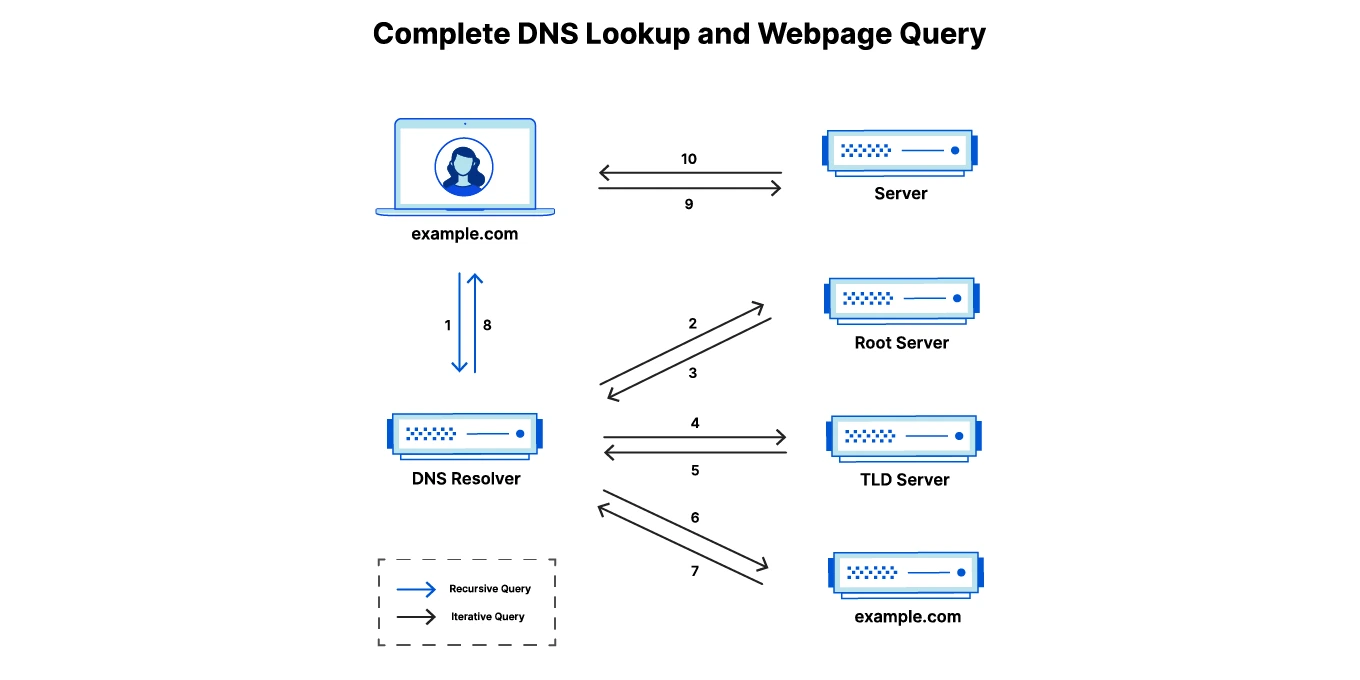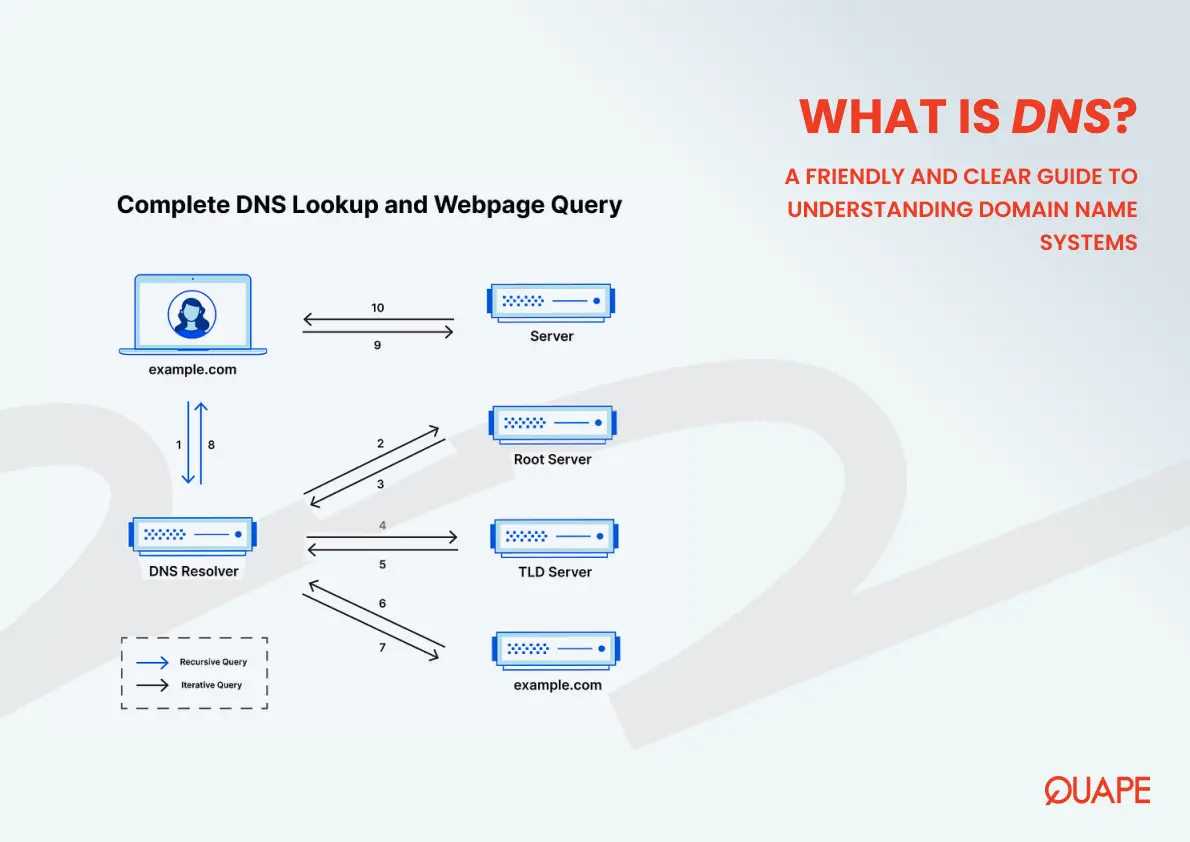Imagine you want to call a friend, but instead of using their name in your phone contacts, you had to remember their full phone number every single time. That would be exhausting. The internet works in a similar way computers talk to each other using IP addresses (strings of numbers like 172.217.14.206), but remembering those numbers is impossible for most of us.
That’s where DNS the Domain Name System comes in. You can think of it as the internet’s phonebook. When you type a website name into your browser, say myportfolio.com, DNS quietly and instantly translates that easy-to-remember name into the IP address of the computer (server) that hosts the site. Without DNS, you’d be stuck memorizing numbers instead of names.
Table of Contents
ToggleWhat Is DNS?
The Domain Name System (DNS) is like the internet’s worldwide address book only much faster and smarter. Its job is simple but critical: it matches human-friendly domain names (like example.com) with machine-friendly IP addresses (like 93.184.216.34).
Think of it as a super-efficient receptionist for the internet. You say the name of the person you want to reach, and in milliseconds, DNS gives you their direct phone number so you can connect.
This “phonebook” isn’t stored in one place it’s a global, hierarchical network of servers, each responsible for a piece of the puzzle. And it works so quickly that you rarely notice it’s happening, even though it’s essential for nearly every click, tap, and search you make online.
How Does DNS Work?

Let’s walk step-by-step through what happens when you type example.com into your browser:
1. You type the domain name.
You enter example.com into the address bar and hit Enter. Your browser needs to know the site’s IP address before it can connect so it asks the question:
“What’s the numeric address for example.com?”
2. The recursive resolver takes charge.
This resolver is like your personal internet assistant. It’s usually operated by your internet service provider (ISP) or a public DNS service (like Google DNS at 8.8.8.8 or Cloudflare DNS at 1.1.1.1). Its job? Find the answer for you even if it has to ask other servers along the way.
3. Checking the cache.
Before doing any hard work, the resolver checks its memory to see if it has the answer stored from a previous request. If it finds the IP address, you get an instant response. If not, the resolver begins a DNS lookup journey.
4. Asking the root name server.
The resolver starts at the very top of the DNS hierarchy one of the root name servers. These servers don’t know every address, but they know where to point you next. In this case, the root server says:
“I don’t know example.com’s IP, but I know which server handles .com domains.”
5. Visiting the TLD server.
TLD stands for Top-Level Domain the part of the domain after the dot (e.g., .com, .org, .net). The .com TLD server tells the resolver:
“For example.com, you need to talk to this authoritative nameserver.”
6. Getting the final answer.
The authoritative nameserver is like the official spokesperson for a domain. It stores the actual DNS records, including the A record (which maps the domain name to an IP address). This server responds with the precise IP address your browser needs.
7. Returning the IP address to your browser.
The resolver delivers the IP address to your browser, which then uses it to request the website’s content from the correct server. All this happens in milliseconds.
Thanks to caching, the resolver remembers the answer for a certain amount of time defined by the TTL (Time To Live). So if you or someone else requests the same domain again soon, the process skips most of these steps.
Also Read: What Is IP Address? Understanding How the Internet Knows Where You Are
Why Is DNS Important?
Imagine trying to explore a city without street names only with raw GPS coordinates. That’s what the internet would feel like without DNS. You’d have to memorize dozens (or hundreds) of long IP addresses just to check your email, read the news, or watch a video.
DNS not only makes the web human-friendly, but it also adds flexibility. Website owners can switch hosting providers or move to different servers without changing the domain name people type they just update the DNS records in the background.
In short, DNS is one of the unsung heroes of the internet: invisible, fast, and absolutely essential.
Types of DNS Queries
DNS lookups aren’t always the same there are three main styles:
- Recursive queries – The resolver takes full responsibility for finding the answer. It keeps asking other servers until it either gets the IP address or confirms it doesn’t exist.
- Iterative queries – The resolver gets partial answers and follows a chain of referrals from one server to the next until it finds the final answer.
- Non-recursive queries – The resolver already knows the answer (usually from its cache) and responds immediately without contacting any other servers.
Caching is critical here it speeds up browsing, reduces network load, and avoids repeating the same work over and over.
Extra DNS Superpowers
While DNS is best known for helping browsers find websites, it can do much more:
- Email routing – Through MX (Mail Exchange) records, DNS directs emails to the correct mail servers for a domain. Without it, email delivery wouldn’t work.
- Reverse lookups – Using PTR (Pointer) records, DNS can look up the domain name associated with a given IP address. This is often used for server validation and spam prevention.
- Privacy upgrades – New protocols like DNS over HTTPS (DoH) encrypt DNS requests, hiding them from potential snoopers and adding an extra layer of security.
Security Risks
Because DNS is so critical, it’s also a target for cyberattacks:
- DNS cache poisoning – Attackers insert false information into a resolver’s cache, tricking users into visiting malicious sites.
- DNS hijacking – Traffic is redirected to rogue servers, often to steal data or inject malware.
- DDoS attacks – Massive floods of traffic overwhelm DNS servers, making websites temporarily unreachable.
To counter these threats, administrators often use multiple DNS servers, redundancy, and security protocols like DNSSEC (Domain Name System Security Extensions).
In Summary
DNS is one of those invisible technologies you never think about until it stops working. It’s the internet’s translator, converting easy-to-remember names into the numeric addresses computers use to talk to each other. From the moment you type a URL to the instant the site appears, DNS is quietly making the connection happen.
Without it, the internet would be an unrecognizable mess of numbers. With it, we enjoy a web that’s simple, human-friendly, and lightning fast.
- Colocation vs Cloud: An In-Depth Comparison - October 1, 2025
- Pros & Cons: Colocation vs Dedicated Server - September 30, 2025
- What Is a Data Center and How Businesses Use It Every Day - September 29, 2025




